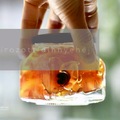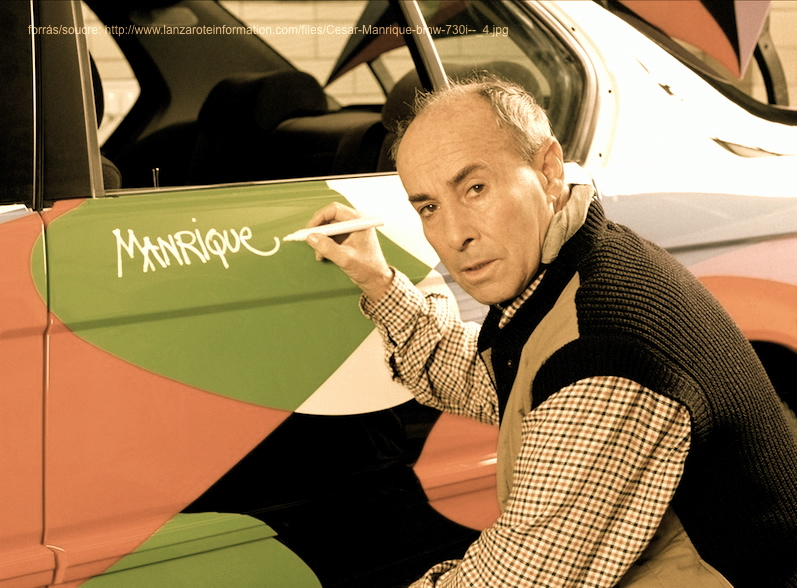
Nemrégiben a spanyolországi Lanzarote szigetén jártunk. Annak érdekében, hogy a sziget a turisták szemében is vonzó célponttá váljon, rendkívül sokat tett César Manrique. Azontúl, hogy a szigetet, s Manrique kézjegyét magán viselő nevezetességeket keresztül-kasul bejártuk, ellátogattunk a művész utolsó otthonába is.
This September we visited Lanzarote which is a Spanish island. Its tourist potential has been recognized by César Manrique. However we have visited almost all must-see places, designed by Manrique, we were curious about his last home in Haria as well.
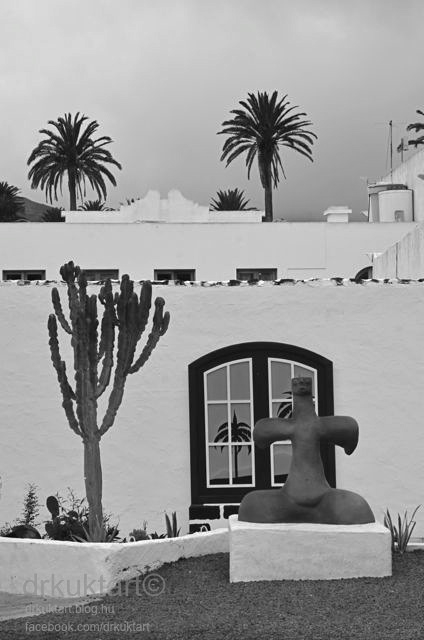
Lanzarote szigetéről nem árt tudni, hogy az Atlanti-óceánban található Kanári-szigetek legrégebbi, legkeletibb-északibb és negyedik legnagyobb szigete, amelyet a rajta emelkedő csaknem háromszáz vulkán után szokás a Száz vulkán szigeteként is emlegetni. Leíró elnevezéssel illették az őslakosok is, hiszen a "Színes hegyek" elnevezés tőlük származik. Nevére történelmével és kopár, növényzettel alig borított, ámde mégis színpompás hegyeivel is rászolgál. A Lanzarote elnevezést Lancelotto Malocello genovai tengerészt ragasztotta rá, aki Európából elsőként jutott el ide a XIV. században. A Wikipédia szerint "a sziget (…) sokáig a marokkói kalózok rajtaütéseinek célpontja volt. Az akkori fővárost, Teguisét rendszeresen kifosztották, lakóit százszámra ejtették foglyul és adták el rabszolgának. A probléma a 16. században vált különösen súlyossá, miután a marokkói kalózok mellett megjelentek az angol tengeri rablók (…) és a halálfejes zászló alatt hajózó franciák (...). A 17. század közepére a kalózok és a tömeges kivándorlás miatt a sziget lakossága 300 főre csökkent. Az 1730-as évek hatalmas vulkánkitörései jórészt elpusztították a sziget legjobb termőföldjeit, de a vulkáni hamu rendkívül alkalmasnak bizonyult egyes gyümölcsök (így a szőlő) termesztésére. A sziget borait az elmúlt évek során kezdték el igazán meg/elismerni, bár minőségükről megoszlanak a vélemények. (…) A 846 km² területű sziget hossza 60 km, szélessége 12 km. Partvonala 213 km, ebből strandolásra alkalmas 16,5 km (homokos 10 km), a többi sziklás. (…) Az utolsó vulkánkitörés 1824-ben volt."
'Lanzarote, a Spanish island, is the easternmost of the autonomous Canary Islands, in the Atlantic Ocean. (…) Covering 845.9 square kilometers, it is the fourth largest of the islands. The first recorded name for the island, given by Angelino Dulcert, was Insula de Lanzarotus Marocelus, after the Genoese navigator Lancelotto Malocello, from which the modern name is derived. The island's name in the native language was Tyterogaka or Tytheroygaka, which may mean "one that is all ochre" (referring to the island's predominant color). Lanzarote is located 11 km north-east of Fuerteventura and just over 1 km from Graciosa. The dimensions of the island are 60 km from north to south and 25 km from west to east. Lanzarote has 213 km of coastline, of which 10 km are sand, 16.5 km are beach, and the remainder is rocky.' (Source here.)
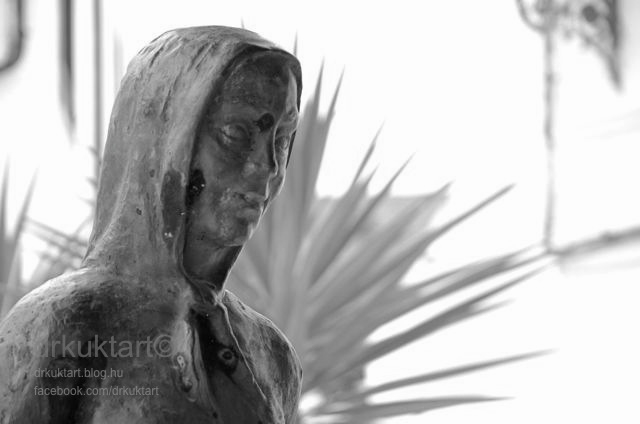
César Manrique utolsó lakhelye az Ezer pálma völgyében megbújó Haria városában volt. A helyiek szerint ez a hely a sziget oázisa. Bár ezer pálmát nem volt alkalmunk összeszámolni, s szeptemberben, az egyik legmelegebb hónapban jártunk erre, így fűnek sem nagyon láttuk nyomát, az tény, hogy a város Lanzarote más tájegységeinél zöldebb területen fekszik. Haria, néhol csupán egy személygépkocsi szélességű kacskaringós utcáinak labirintusával csalogatja a művész otthonát felfedezni vágyókat.
The last home of César Manrique was in Haria which is located in the Valley of Thousand Palms, which is also known as the oasis of Lanzarote. However we had no possibility to count thousands of palms and we visited the island in one of the warmest month, it's true that Haria is greener than other parts of Lanzarote.
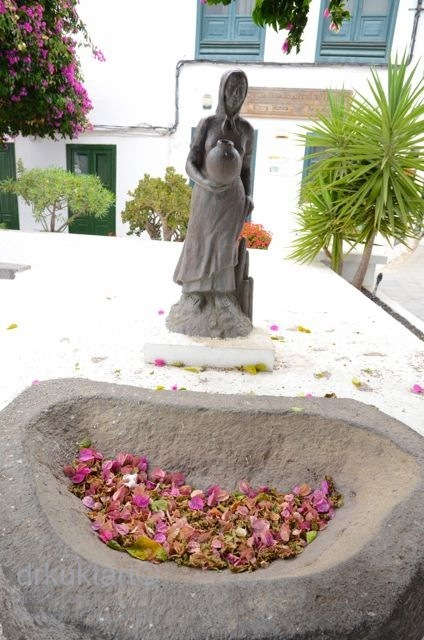
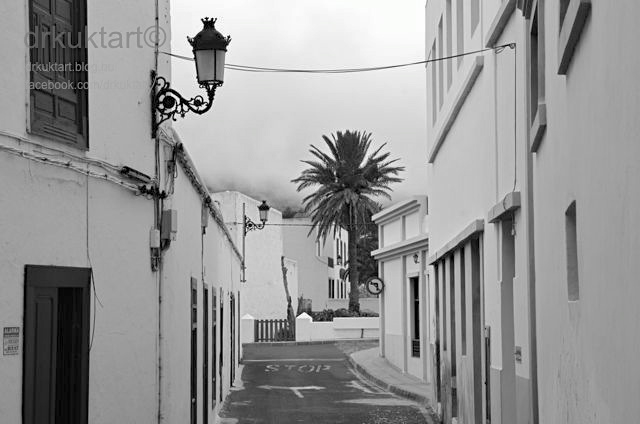
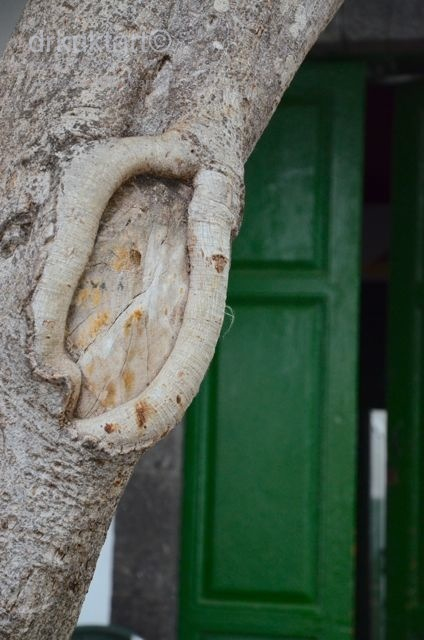
Haria jellegzetes Lanzarote-i város a maga zöld kapuival és ablakaival. Magában a városkában nem sok időt töltöttünk nézelődéssel, csupán végiglejtettünk pár utcácskán és meghívtuk magunkat egy csésze finom kávéra. Ezt követően célirányosan a Casa Haria felé vettük az irányt. Érdekesség, hogy egy, a Lanzarote-t népszerűsítő honlap amellett, hogy programokat, étteremeket ajánl a vásorban, s leírja Haria történetét, még azt is elárulja, hogy, ha a sziget szépségeinek hatására a megfáradt utazó (az interneten keresne megnyugvást…) ingyen wifi-t keresne, azt a könyvtár mellett ilyen és ilyen kóddal (eseteként anélkül) tudja elérni.
Haria is a typical Lanzarote town with its green doors and windows. We didn't spend much time with sightseeing: just took a short walk and drink a perfect cup of espresso.
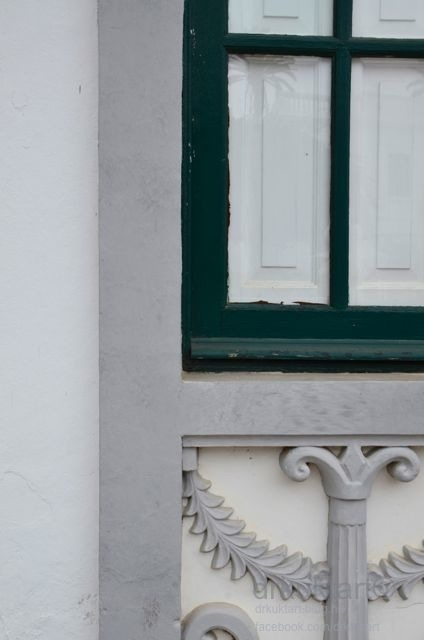
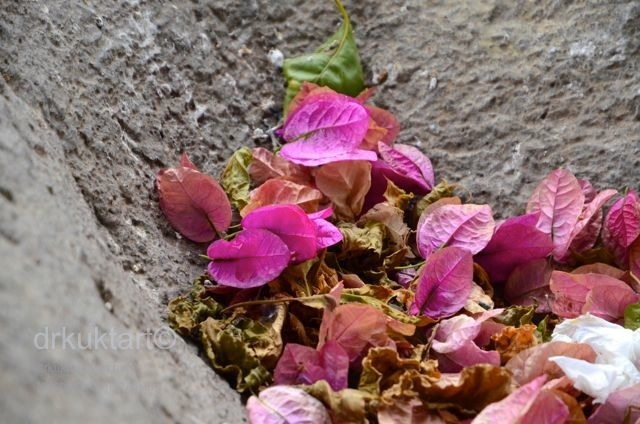
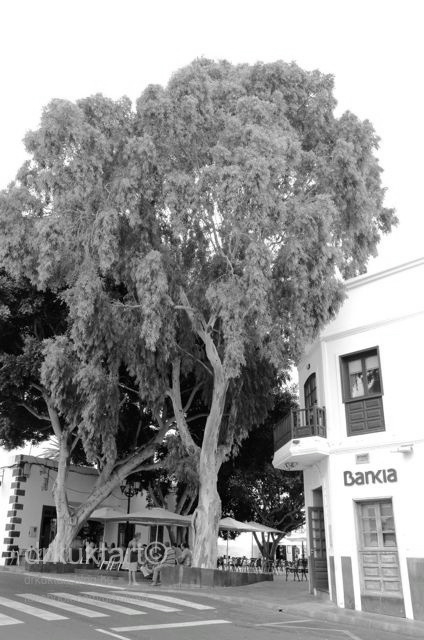
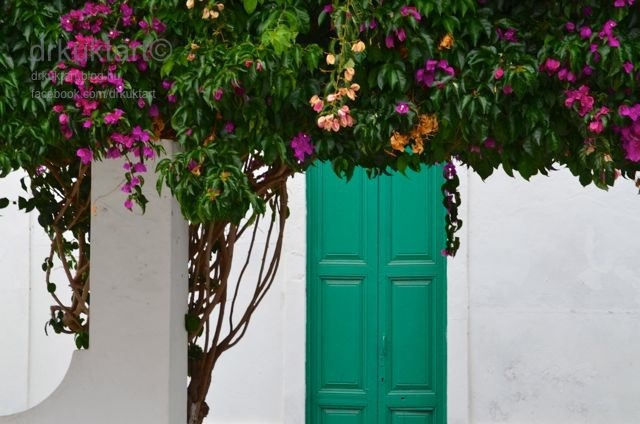
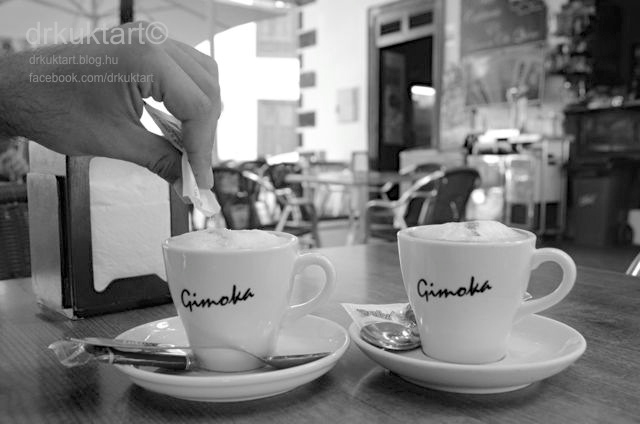
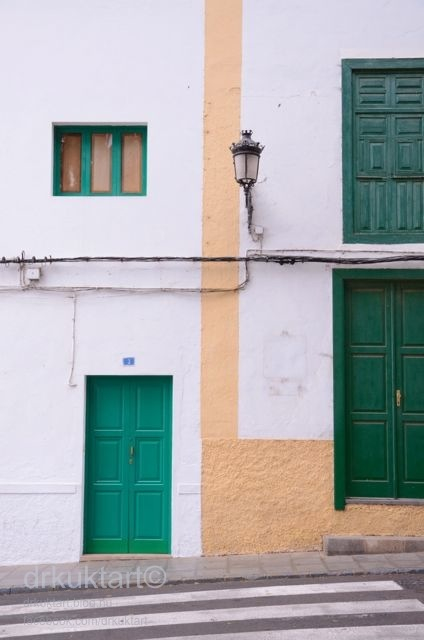
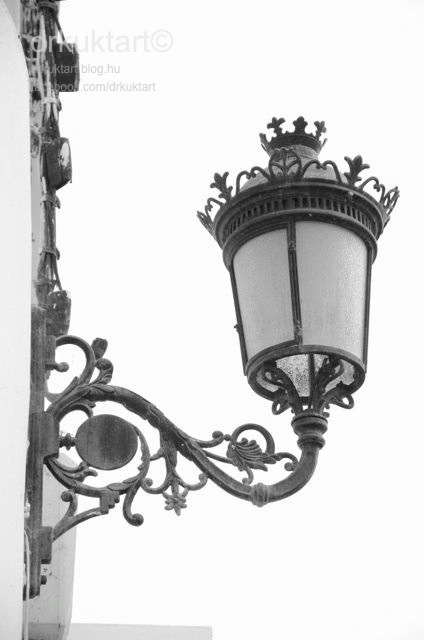
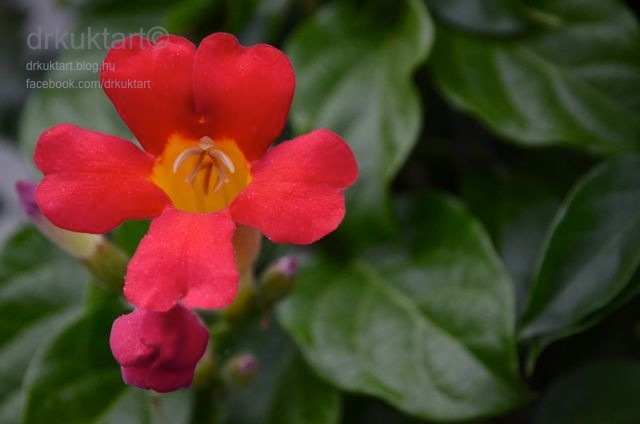
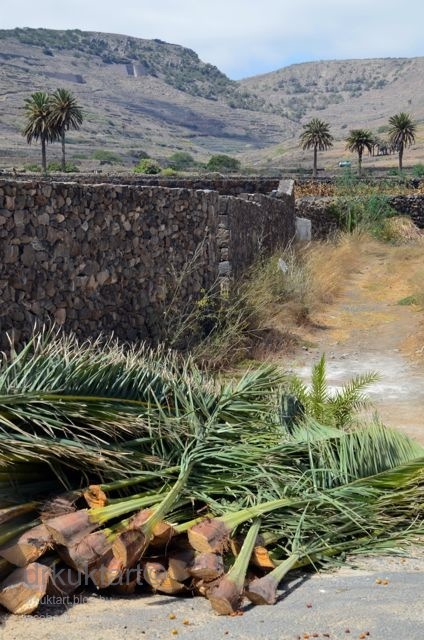
Bár meglehetősen gazdagon táblázott a múzeumhoz vezető útvonal (mondhatni minden tábla erre mutat), az utolsó szakaszon, ahol az elveszett turista több ponton is válaszút elé érkezik, tábla nincsen. Végezetül csak belefutottunk a Casa Haria-ba, amely a város szélén, a Teguise-ből vezető helyi útról is az ég felé nyúló zászlók által jelölten helyezkedik el, stílusosan a Calle César Manrique-n.
Many plates are placed everywhere in the town to show the right direction to Casa Haria. The funny thing is only the last part of the way to the museum suffers the lack of plates, however the tourists may get lost in the labyrinth of crossing streets. After driving a bit longer than it was necessary we found the Casa Haria in Calle César Manrique, which is located close to the road comes from Teguise.
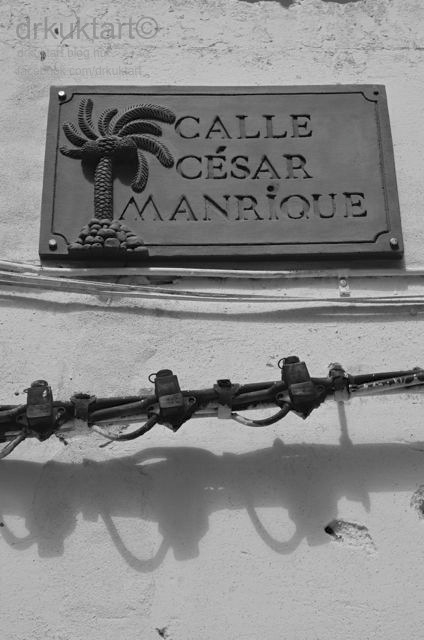
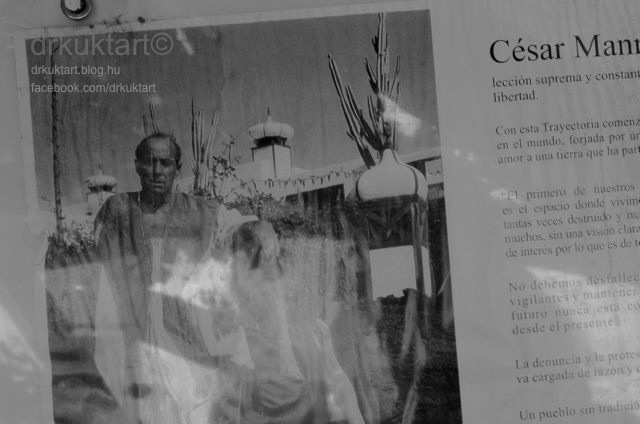
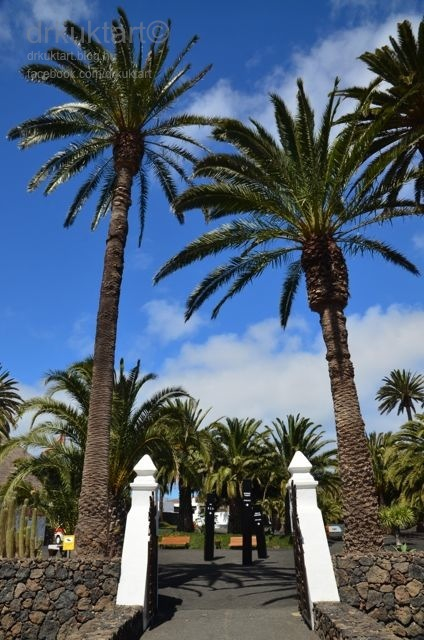
A bejárat, s a mögötte megbújó kert. Természetesen a Haria-ra oly' jellemző pálmafák népesítik be a hatalmas telket.
The entrance of the courtyard. The courtyard is full with palm trees which are the characteristic trees of the valley of Haria.
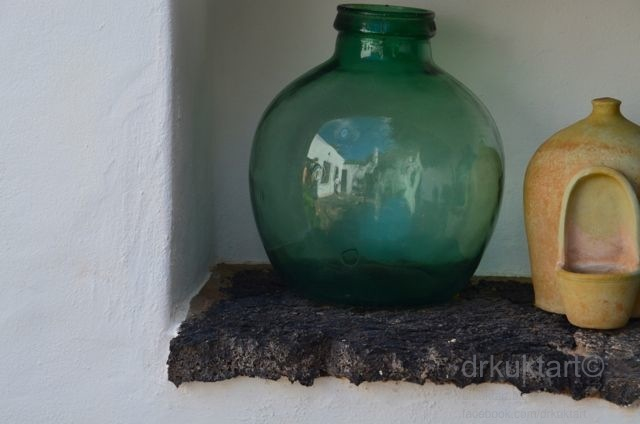
César Manrique 1919. április 24-én született Lanzarote-n Arrecife városában. A spanyol polgárháborúban Franco oldalán harcolt önkéntesként a tüzérségben. Ezt követően a La Laguna-i Egyetemen építészetet tanult, de két év után felhagyott itteni tanulmányaival. Az 1945. évben Madridba költözött, majd ösztöndíjasként a San Fernando-i Művészeti Iskolában tanult, ahol festészet-művészet szakirányon végzett tanárként. 1964-1966. között New Yorkban élt, ahol aktívan alkotott. Lanzarote kapcsán elmondható, hogy César Manrique munkássága igencsak jelentős Lanzarote mai arculatának kialakítása szempontjából. A művész felismerte, hogy a sziget miként tehető a turisták számára vonzóvá, és ennek érdekében tervezett és alkotott itt. Munkái a sziget számos pontján megtalálhatóak, körforgalmakban magasodnak az autósok fölé, barlangokban ölelnek körbe, éttermekben, kilátókban köszönnek vissza. Fontosnak tartotta az épített környezet és a természeti világ közötti összhangot. Manrique 1992. szeptember 25-én hunyt el autóbalesetben a szigeten Teguise-ben.
Unfortunately the website of César Manrique Foundation is not available in English so I had to search another source to summary some information about the artist. According to one of the websites 'Manrique was born in Arrecife, Lanzarote. He fought in the Spanish Civil War as a volunteer in the artillery unit on Franco's side. He attended the University of La Laguna to study architecture, but after two years he quit his studies. He moved to Madrid in 1945 and received a scholarship for the Art School of San Fernando, where he graduated as a teacher of art and painting. Between 1964 and 1966 he lived in New York, where a grant from Nelson Rockefeller allowed him to rent his own studio. He painted many works here, which were exhibited in the prestigious "Catherine Viviano" gallery. Manrique had a major influence on the planning regulations in Lanzarote, when he recognised its tourist potential and lobbied successfully to encourage sympathetic development of tourism. One aspect of this is the lack of high rise hotels on the island. Those that are there are in keeping with the use of traditional colours in their exterior decoration. Manrique died in a car accident at Tahíche, Teguise, very near the Fundación, his Lanzarote home, in 1992. He was aged 73.'
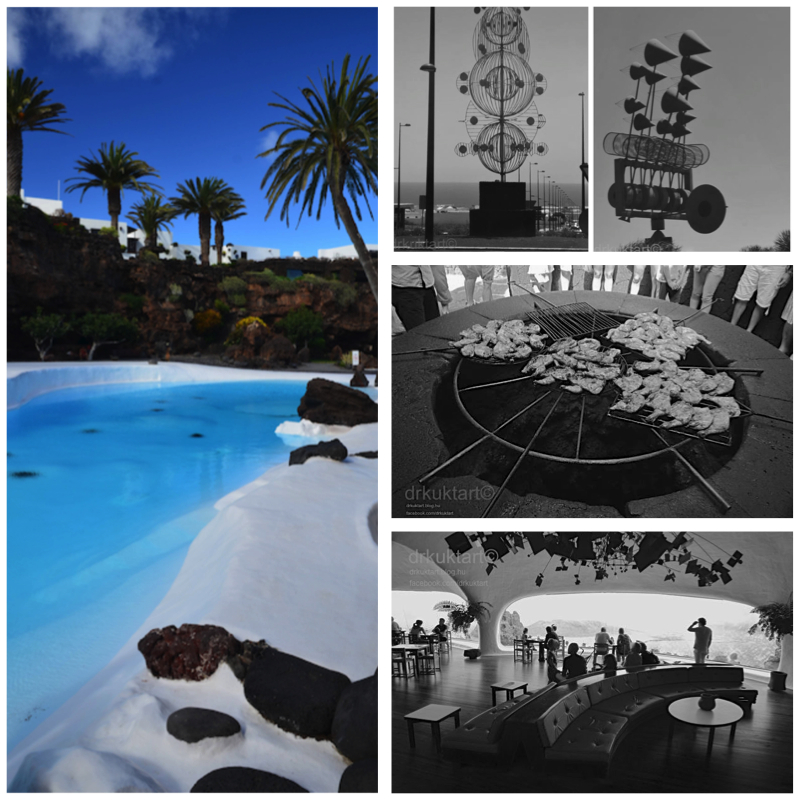
A fenti kollázson néhány olyan látványosság látható, amelyet Manrique tervezett Lanzarote-ra: ilyen a spanyol király medencéje az egyik vulkanikus barlangban, a szabadtéri szobrok a körforgalmakban, a vulkánból kiáramló hő felhasználásával üzemelő grillsütő vagy a páratlan kilátással büszkélkedő kilátó a sziget csücskében. Ezeket mind meglátogattuk és nem leszek rest Titeket is lenyűgözni az ott látottakkal hamarosan.
You can see some attractions, designed by Manrique above for example the pool of the Spanish king which was designed in a cave of volcano, the statues in traffic cycles, grill which was designed to use the heat of one of the volcanos and the look-out place with extraordinary view. We visited almost all of them, so I will show many of them for you, that's for sure.
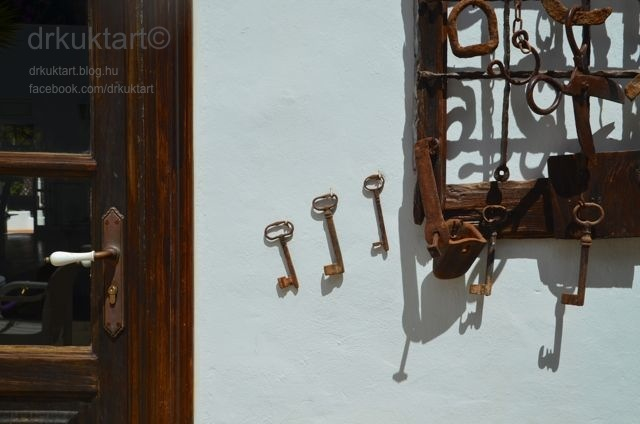
A művész 1988-1992. között élt, s alkotott itt.
He lived and worked here between 1988 and 1992. The artist moved to this quiet town in pursuit of serenity and the inspiration for his painting that he found in the nature. In Haria he found both, as well as the pleasure he derived from the surroundings. In early 1986, Manrique undertook construction on his new house, recycling and adapting a run-down farmhouse located in the palm orchard he had purchased in the nineteen seventies. The home is a prime example of intervention in a dwelling representative of rural island architecture, reinterpreted by César Manrique from a contemporary perspective. In addition to his own living quarters, he built an apartment for the domestic workers, a studio-workshop and a number of garages.
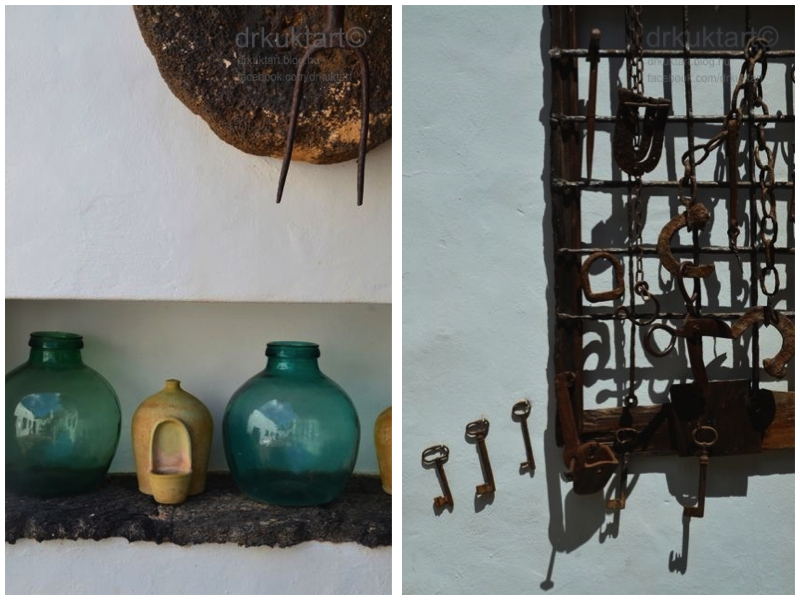 A belépőjegyet meglehetősen borsosan mérik, tíz euró fejenként felnőttenként, bár azt is meg kell, hogy jegyezzem, hogy majdnem minden - Manrique által újragondolt - látványosságot kilenc euró körüli összegért tekinthetünk meg a szigeten. A nyitvatartásra érdemes figyelni, ugyanis annak ellenére, hogy hosszúak a nappalok, a múzeum délután 14:30-ig van nyitva, az utolsó látogatás pedig 13:50-kor indul. Meglehetősen egyedi nyitvatartási idő, de mi szerencsések voltunk, mert egykor érkeztünk. Bővebb információ itt érhető el a jegyekről és a nyitvatartásról.
A belépőjegyet meglehetősen borsosan mérik, tíz euró fejenként felnőttenként, bár azt is meg kell, hogy jegyezzem, hogy majdnem minden - Manrique által újragondolt - látványosságot kilenc euró körüli összegért tekinthetünk meg a szigeten. A nyitvatartásra érdemes figyelni, ugyanis annak ellenére, hogy hosszúak a nappalok, a múzeum délután 14:30-ig van nyitva, az utolsó látogatás pedig 13:50-kor indul. Meglehetősen egyedi nyitvatartási idő, de mi szerencsések voltunk, mert egykor érkeztünk. Bővebb információ itt érhető el a jegyekről és a nyitvatartásról.
An adult ticket costs EUR 10. Don't forget to check opening hours before visiting, because it's quite unordinary. It's open until 14:30 and the last visit starts at 13:50. For more information about tickets and opening hours click here.
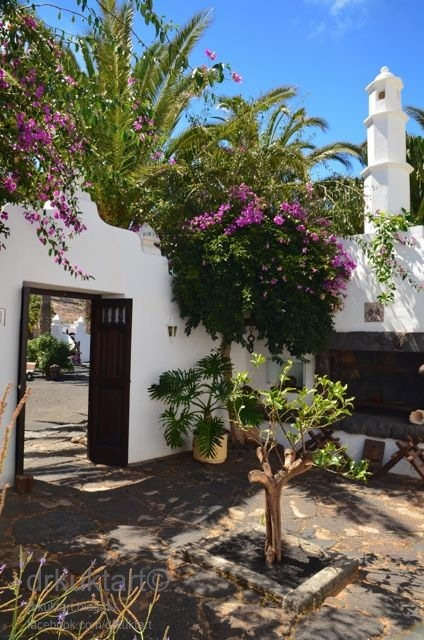
A házat körbeölelő előudvarba nyíló faajtó a sziget népi építészetének - Manrique által modrenizált - egyik jeles darabja. A kis udvart borító bazalt kövezet a szigetről származó helyi alapanyag, amelyet Manrique igencsak gyakran használt munkássága során.
The wooden door through which you can enter the front courtyard, represents the vernacular architecture of Lanzarote, modernized by Manrique. The basalt paving stone which floors this courtyard is a local material which was frequently used by the artist.
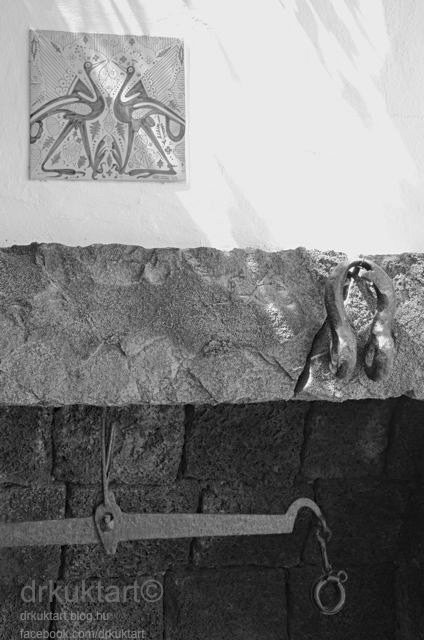
A kisebb udvaron álló hagyományos tűzhely természetesen bazaltból készült, amelyet a szigeten folytatott mezőgazdasági és halászati tevékenységhez használt eszközök díszítenek. Nemcsak az udvart, de az otthont is a fekete bazalt, a fehérre mázolt falak és a növények zöldjének hármasa uralja.
Traditional oven which is made from basalt and decorated by farming and fishing utensils of the island culture.
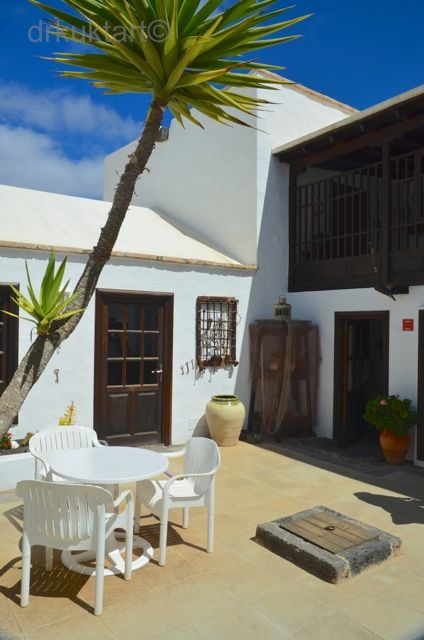
Sajnos magukban az épületekben nem szabadott fényképet készíteni, de a kertben, a szabadban igen. Így kivételesen ahhoz a sajátos megoldáshoz folyamodtam, hogy César Manrique-ről, valamint otthona belső tereiről az internetről szedtem össze képanyagot (a képeken jelöltem a forrást), annak érdekében, hogy ne csak a a kertben gyönyörködjünk. Az így összeszedett képanyag meglehetősen vegyes és annyiban hiányos, hogy számos helyiségről (így a természettel mintegy egybeolvadó három fürdőszobáról, továbbá a vendégfürdőről, valamint a tágas nappaliról és étkezőről) egyáltalán nem találtam fotókat. Minden, amit láthattunk eredeti állapotban maradt meg, és a belső helyiségekben kiállított fotókról a tárgyak ugyanilyen elrendezésben köszönnek vissza.
Taking photos in the building is not permitted so I was searching pictures about the rooms for you on the internet (indicating the source as well). Unfortunately there is no photo about all the rooms (i.e. about the unique bathrooms, the whole dining room).
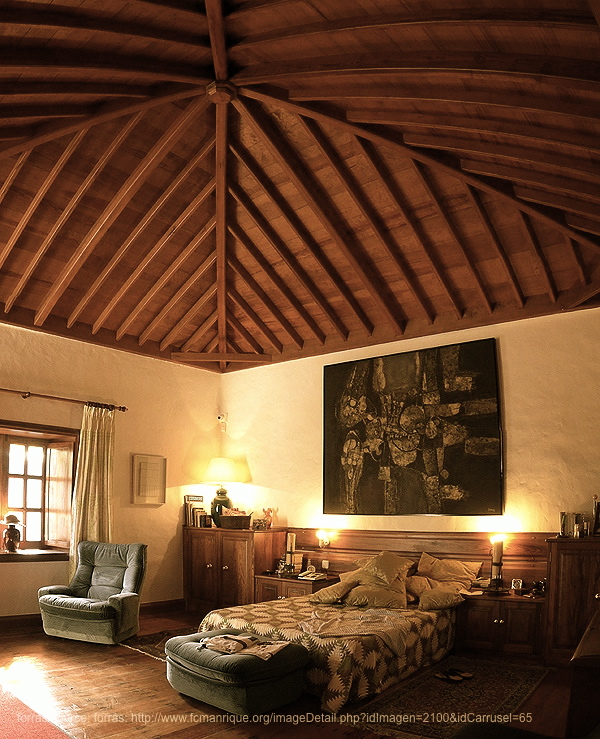
A hálószoba, amely a nappaliból nyílt, s amelyből Manrique részben üvegfalú fürdőszobája nyílik.
Manrique's bedroom which opens on one side to his private bathroom and on the other side to the living room. His private bathroom is bordered by glass from one side and shows the nature behind the glass.
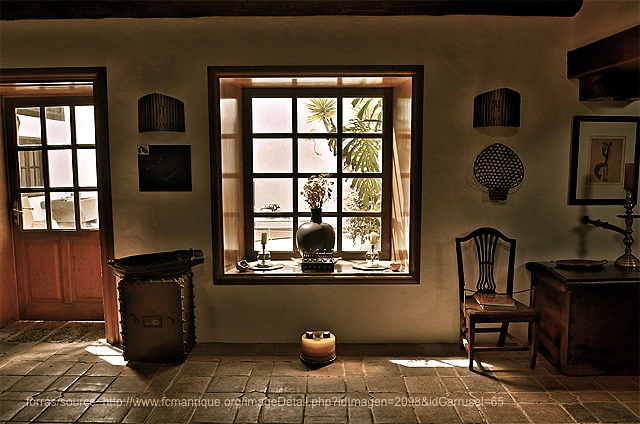
A fent látható kisebb udvarra nyíló nappali egy részlete.
One side of the living room with the window which opens to the small courtyard mentioned above.
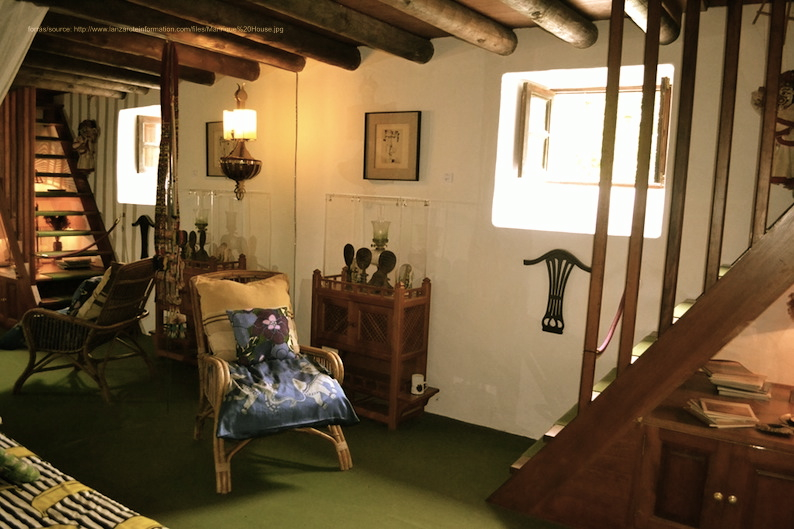
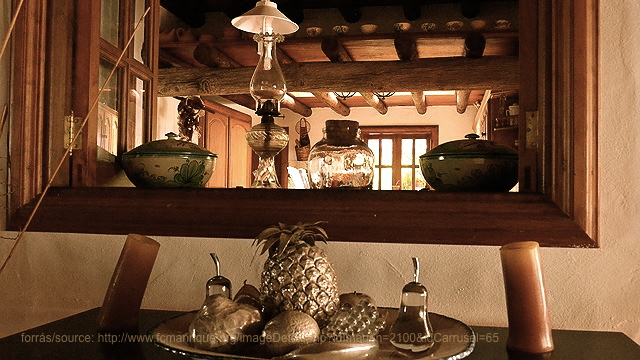
A konyha egy részlete az átadóablakkal.
One corner of the kitchen and the living room.
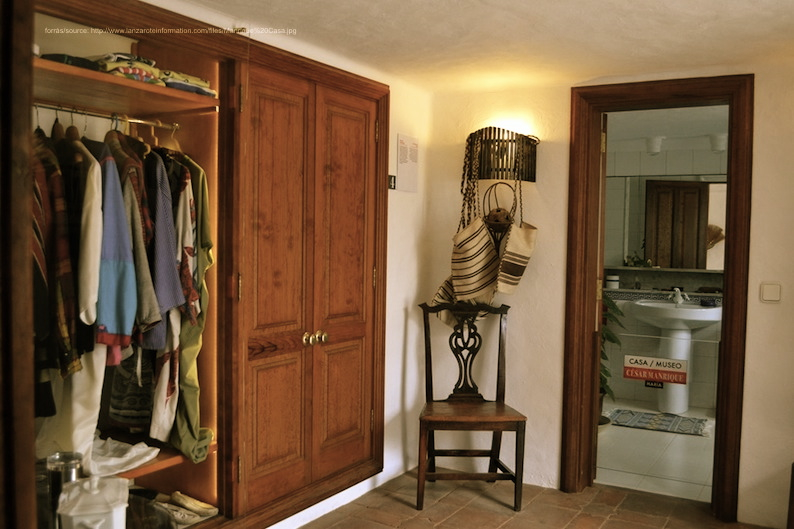
Az egyik előszoba.
One of the halls.
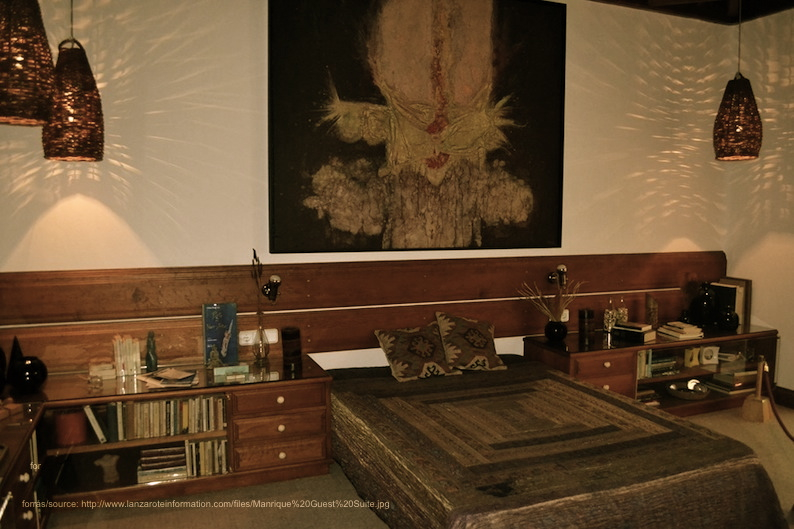
Vendégháló.
Guest room.
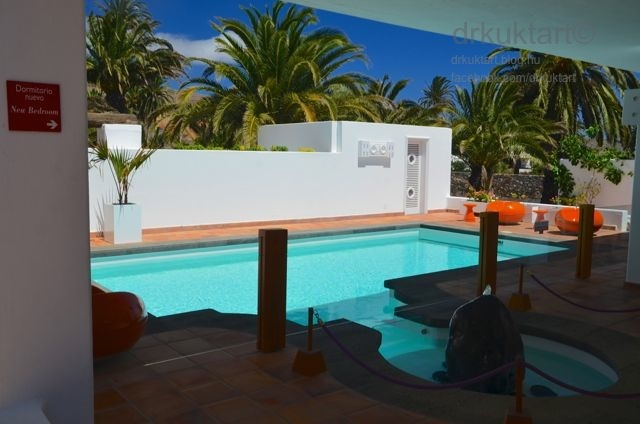
A medence és a környékén kialakított pihenő. Innen nyílik egyébként a már fent látott vendégszoba és az ahhoz tartozó szintén vendégháló nagyságú és részben üvegfalú, padlószőnyeggel borított vendégfürdőszoba.
The pool and the leisure area. The guest room opens here. A quite big bathroom (almost the same size as the guest room) for guests belongs to the guest room as well. This bathroom is also bordered by glass on one side and covered by wall-to-wall carpet on the ground.
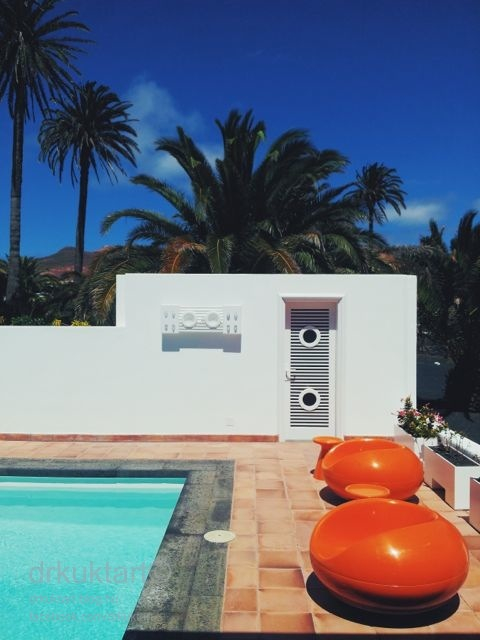
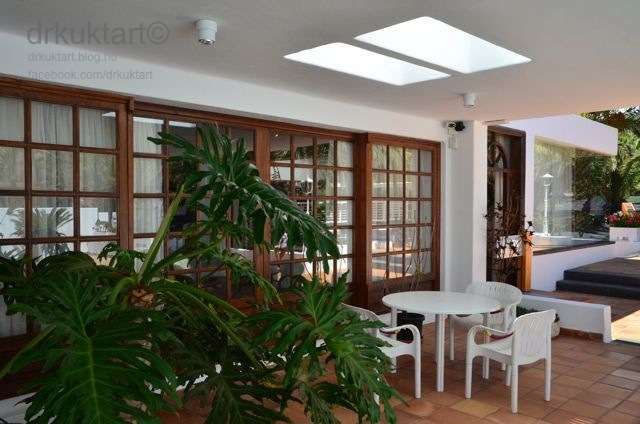
A nappali medencére néző ablakai.
The windows of the living room open to the swimming pool.
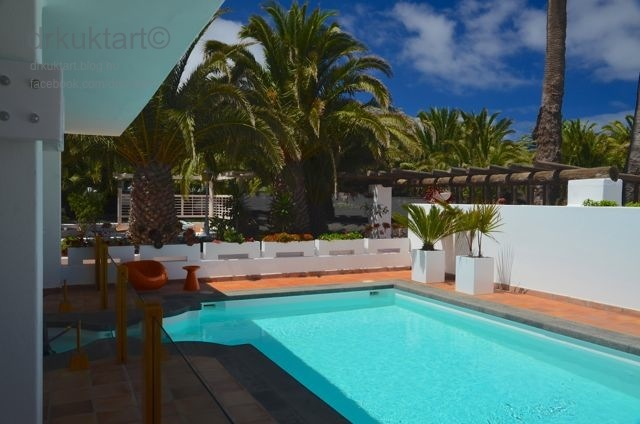
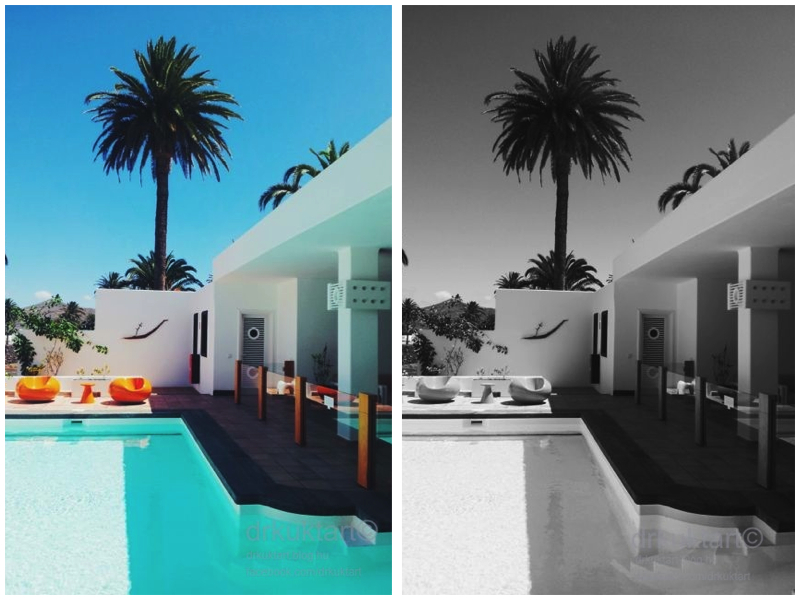
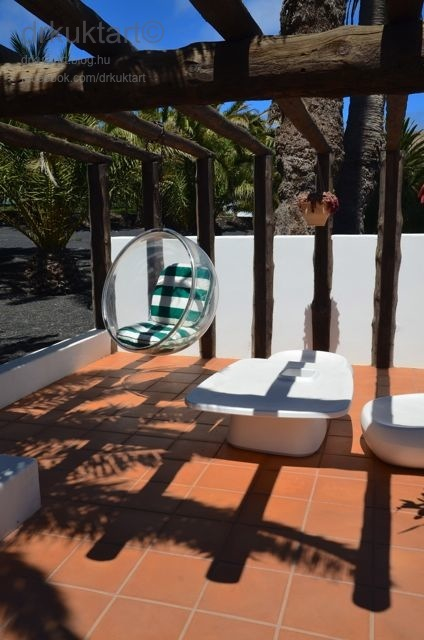
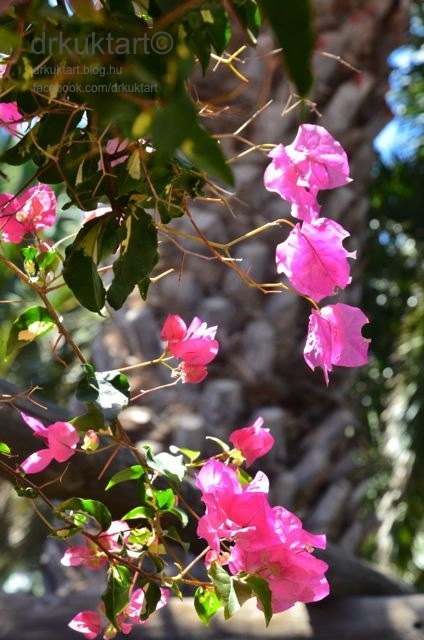
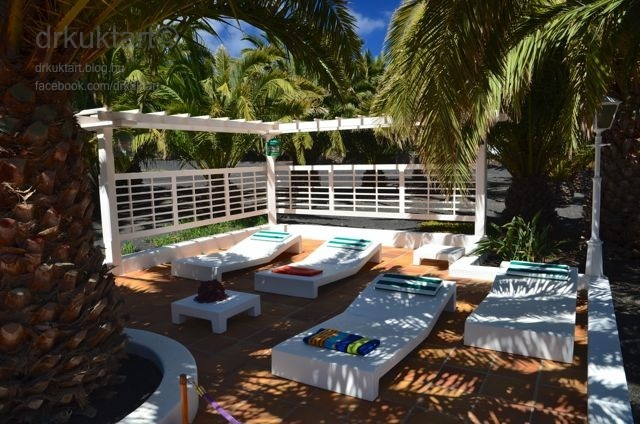
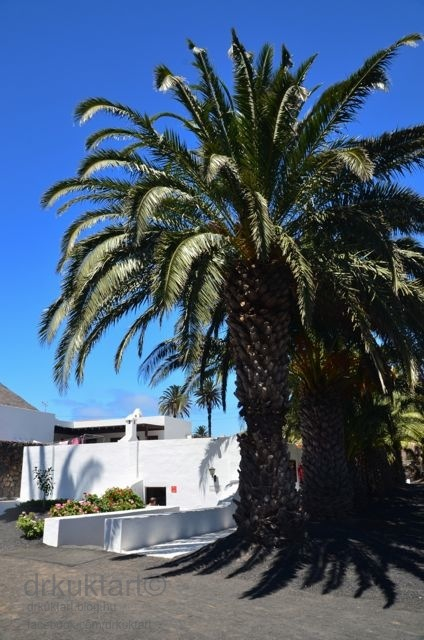
A házat elhagyva bazalt kavicsos kerten áthaladva érjük el a félig a földbe süllyesztett műtermet, ahol szintén tilos volt fotókat készíteni, így itt is az internetet hívtam segítségül. A műterem felülvilágító-, illetve az épület oldalán található ablakokon át kapja a művésznek oly' fontos volt természetes fényt, s a helyiség végében Manrique utolsó - immár félbemaradt - alkotása fekszik a földön. Manrique álltólag mindig úgy festett, hogy a vásznat a földre helyezte, s csupán az utolsó apróbb ecsetvonásokhoz, részletekhez helyezte fel a képet az állványra.
By leaving the house you arrive the workshop of Manrique, which was built half-way in the ground. Taking photos was forbidden so I searched photos on the internet. We saw his latest unfinished work in the end of the workshop. It's known that he was painting always on the ground and put it on easel to finalize the smaller parts only at the end.
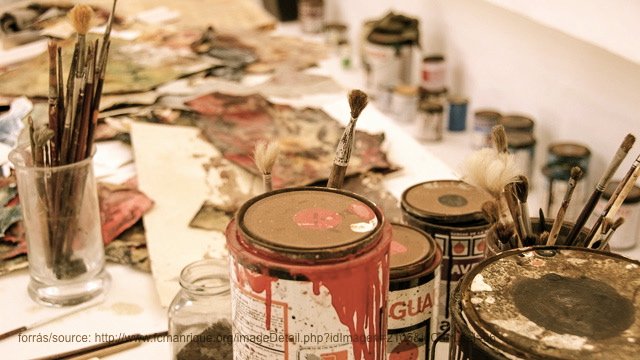
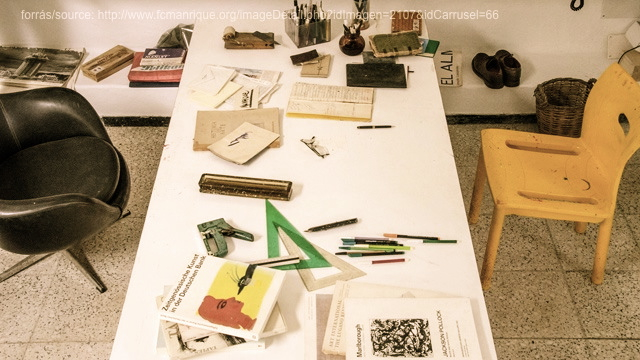
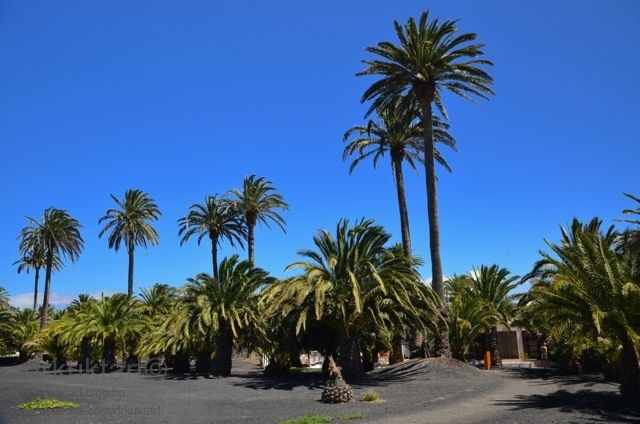
A külső (nagy) kert a műterem felől. Manrique tervezte, hogy tovább bővíti az életterét (és a házát), de ezt már nem fejezhette be.
The view of bigger courtyard from the workshop. Manrique planned to build more rooms to his house but he could not perform it because of his death.
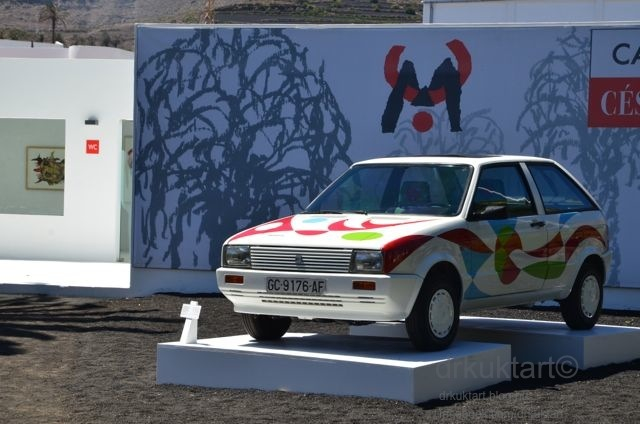
Az udvaron egy, a Manrique által festett Seat került kiállításra.
A Seat which was decorated by Manrique,stands in the bigger courtyard.
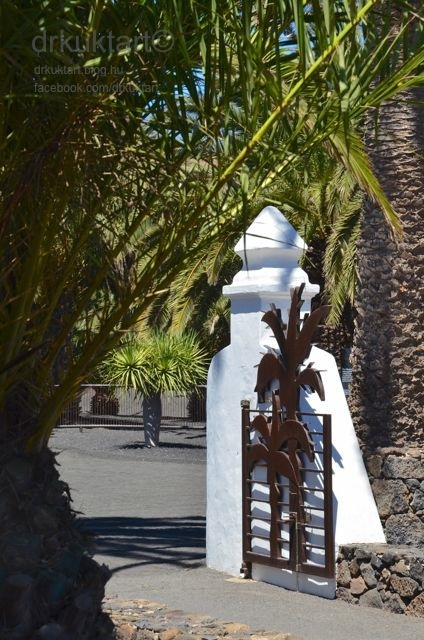
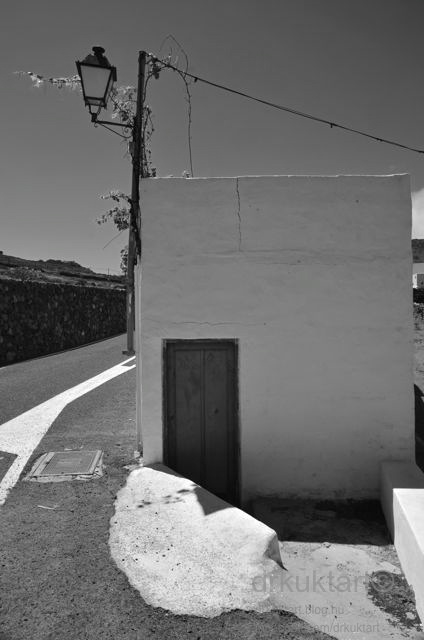
Manrique-ről elnevezett utcácska a sziget többi részéhez hasonlóan kopár, és, hogy a zöldnek még utat se engedjenek, aszfalttal borított.
Calle César Manrique - the street which was named after Manrique.
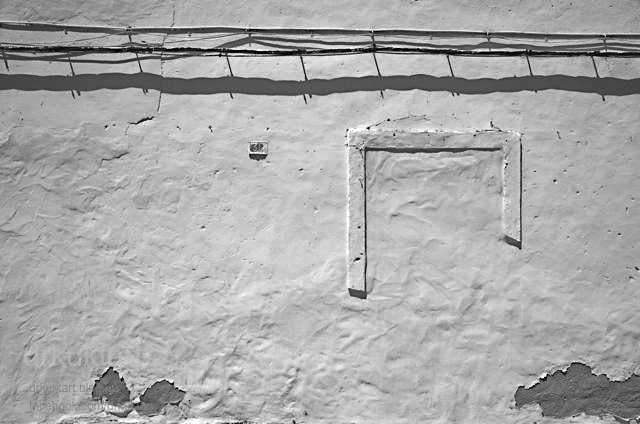
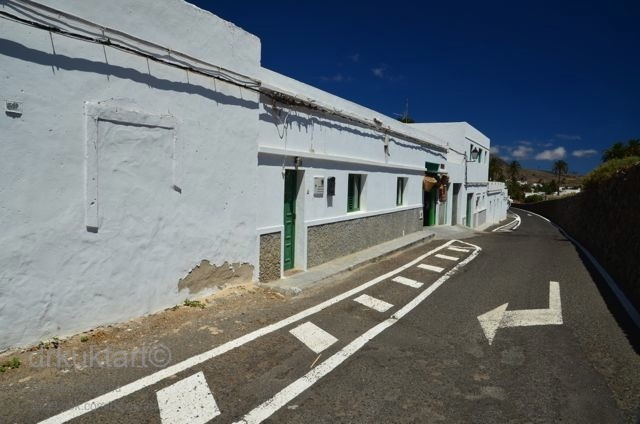
Nehezen leírható, furcsa érzés kerített hatalmába ebben a múzeumban, hiszen majdnem minden úgy és ott található, mint ahogyan és ahol azt a művész hagyta. Figyelemmel arra, hogy munkássága meghatározó volt Lanzarote szempontjából is, javaslom, ha itt nyaralnátok, béreljetek kocsit, és látogassátok meg ezt a sziget szívében megbújó kicsiny várost is a Casa Haria-val egyetemben. Hacsak töredékét is sikerült átadnom Nektek az ott tapasztaltaknak, akkor már elégedett vagyok.
Ha tetszett a bejegyzés, kövess Facebook-on ITT és Instagram-on ITT.
Szép napot kívánok!
It was a strange and mixed feeling to see this house. On the other side I was impressed by his taste and style of living, but on the other side I was upset and sad about he couldn't finished his great plans and work. If you have the chance to visit Lanzarote, rent a car and don't miss Casa Haria of César Manrique, because it's really worth to see
If you like this post, follow me on Facebook HERE or Instagram HERE.
Have a nice day!
DRKUKTA

